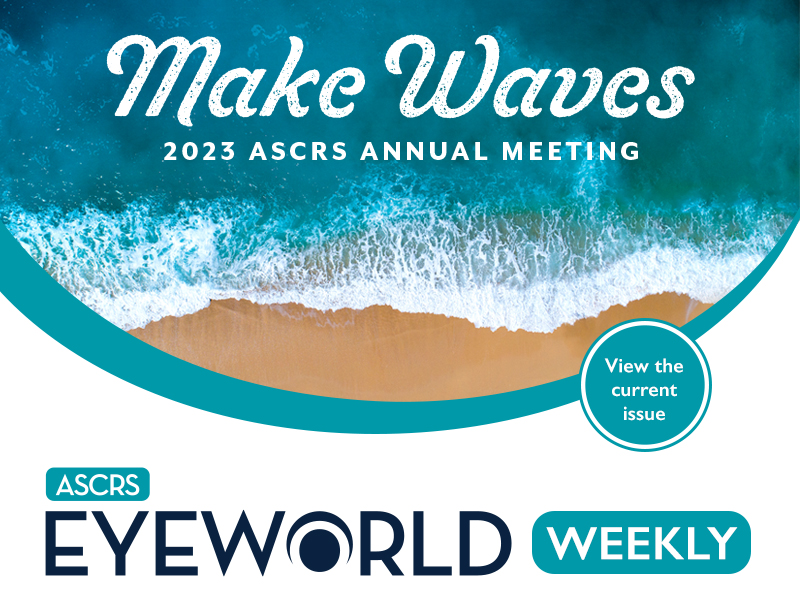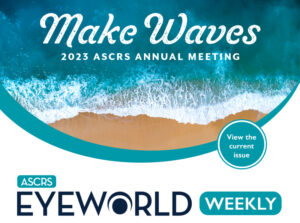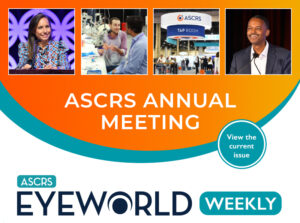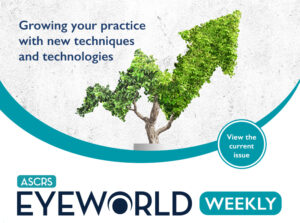
- First in-human, non-invasive femtosecond laser trabeculotomy data
- Special Protocol Assessment received for Phase 2b/3 trial for dry AMD treatment
- FDA gives clearance to IND for geographic atrophy treatment
- Positive preliminary data in trial for retinitis pigmentosa and Leber congenital amaurosis therapy
- Wet AMD treatment proceeds to Phase 2 trial
- ASCRS news and events
April 21, 2023 • Volume 29, Number 16
First in-human, non-invasive femtosecond laser trabeculotomy data
ViaLase announced publication of the first in-human data for its femtosecond laser image-guided high-precision trabeculotomy (FLiGHT) treatment. According to the company, this technology was evaluated in 11 patients (17 eyes) with open-angle glaucoma. The treatment consisted of creating one channel through the trabecular meshwork into Schlemm’s canal. At 24 months postop, there were no device-related adverse events, and the channels were well-defined and open. There was a mean IOP reduction of 34.6% from baseline (from 22.3±5.5 mm Hg to 14.5±2.6 mm Hg). The data is published in the journal Ophthalmology Science.
Special Protocol Assessment received for Phase 2b/3 trial for dry AMD treatment
Allegro Ophthalmics announced that it received a Special Protocol Assessment from the FDA for its Phase 2b/3 clinical trial design for risuteganib (Luminate) for treatment of intermediate, non-exudative AMD (dry AMD). The company stated that this assessment “indicates that the FDA agrees that critical elements of the overall protocol design … are adequate and acceptable for a study intended to support a future marketing application.” According to the company’s press release, risuteganib would be a first-in-class drug for the treatment of intermediate dry AMD. The company has already completed a Phase 2a study, which met its primary endpoint and saw 48% of patients in the treatment arm experiencing an 8 or more letter gain from baseline (7% of patients in the sham group experienced this by week 12). According to the press release, the Phase 2b/3a study will evaluate efficacy at 52 weeks and safety through 96 weeks. It will include 5 intravitreal injections 12 weeks apart with continued intravitreal treatment during the safety portion of the study. The primary endpoint is BCVA at 52 weeks.
FDA gives clearance to IND for geographic atrophy treatment
Aviceda Therapeutics announced that the FDA has cleared its IND for AVD-104, which is an investigational intravitreal ocular treatment for geographic atrophy secondary to AMD. This clearance allows the company to proceed with its Phase 2 clinical trials. According to the company’s press release, AVD-104 is an intravitreal nanoparticle molecule that addresses inflammatory pathways via inhibition of retinal macrophage activity and inhibition of complement cascade amplification.
Positive preliminary data in trial for retinitis pigmentosa and Leber congenital amaurosis therapy
Ocugen announced positive preliminary safety and efficacy data for its Phase 1/2 trial of a retinitis pigmentosa and Leber congenital amaurosis therapy. The therapy—a modifier gene therapy platform, OCU400—is based on treating these conditions due to mutations within the NR2E3 gene and Rhodopsin for retinitis pigmentosa and CEP290 gene for Leber congenital amaurosis. The company’s press release reported a favorable safety profile and visual improvements after treatment with OCU400.
Wet AMD treatment proceeds to Phase 2 trial
Clearside Biomedical announced that it was moving forward with a Phase 2 clinical trial for CLS-AX (axitinib injectable suspension) into the suprachoroidal space as a possible treatment for wet AMD. According to the company, the study will enroll 60 participants who will be randomized 2:1 (40 to receive the investigational treatment and 20 aflibercept alone). There will be a loading dose phase when all participants will receive three doses of aflibercept 2 mg, but those in the study group will also receive CLS-AX 1 mg at the second loading dose of aflibercept. From there participants in the CLS-AX arm will receive CLS-AX at least every 24 weeks unless it’s required more frequently based on disease activity. Patients in the aflibercept arm, after the loading doses, will receive aflibercept every 8 weeks. Enrollment will open this quarter, and topline results are expected in the third quarter of 2024. CLS-AX includes a tyrosine kinase inhibitor that the company thinks could act at a different level in the angiogenesis cascade, benefitting patients who might “sub-optimally respond” to traditional anti-VEGF therapies.
ASCRS news and events
- ASCRS Annual Meeting: Register for the ASCRS Annual Meeting, May 5–8, in San Diego, California. Check the ASCRS ASOA Real-Time Program for the latest program details.
- Eyecelerator: Registration is open for Eyecelerator @ ASCRS 2023. The innovation conference from ASCRS and the American Academy of Ophthalmology will be held on May 4 in San Diego, California. Join investors, industry leaders, and ophthalmologists at this showcase of companies, technology, and other exciting innovation topics in ophthalmology.
- Ophthalmology Quicksand Chronicles—Eureka Moments: The second episode of Season 3 from this ASCRS podcast, hosted by Nicole Fram, MD, and Elizabeth Yeu, MD, is live. Find it here.
Research highlights
- The long-term safety, efficacy, and spectacle independence of treating hyperopic presbyopia with mini-monovision using monofocal IOLs in bilateral cataract surgery was evaluated in a retrospective, non-comparative case series published in the Journal of Cataract & Refractive Surgery. The study included 463 patients and found that both UDVA and UNVA improved significantly postop (mean binocular UDVA from 0.47±0.3 logMAR preoperatively to 0.096±0.14 at postop day 1 and 0.16±0.2 at postop year 10 and mean UNVA of 0.05 logMAR at postop year 10 [at baseline all patients needed spectacles]). A mean UDVA of 0.20 logMAR or more was achieved in 84.29% of patients at postop year 10. Nearly 80% of patients reported being spectacle independent for near vision at postop day 1 and nearly 72% at postop year 10. For distance vision, 86% and 78% of patients were spectacle independent at postop day 1 and year 10, respectively. The authors reported no serious adverse events or photic phenomena. The authors concluded that mini-monovision in patients who were hyperopic presbyopes “is a safe, effective, and low-cost approach for the long-term correction of presbyopia.”
- A single-center, prospective, registry-based study evaluated BCVA of patients before and after having implantable collamer lens (ICL) surgery. The study, which took place between October 2018 and August 2020, included patients with low (0 to –6 D), moderate (–6 to –10 D), and high (more than –10 D) myopia. According to the study, published in Clinical Ophthalmology, 770 eyes of 473 patients were included in the study period; 692 of these eyes completed 1 month of follow-up and were included in the analysis. The authors reported that 69% of eyes achieved a BCVA of 20/20 at 1 month of follow-up; 87% achieved 20/25 or better, and 95% were 20/40 or better. There was a significant improvement in BCVA from baseline, a significant reduction in spherical equivalent, and a significant relationship between preop spherical equivalent and line gain. The authors found a higher line gain in eyes with higher degrees of myopia.
Product news
- Bausch + Lomb and Heidelberg introduced the SeeLuma Fully Digital Surgical Visualization Platform, which features a 3D heads-up monitor and digital display options for “excellent visualization, ergonomics, smooth workflow, and an immersive educational experience,” according to the companies’ press release. This system is launching in the U.S. and some European countries in April.
- Haag-Streit launched its EyeSuite i9.13 upgrade, which includes new features for the Eyestar 900 Anterior Chamber Suite, new functionality for the Lenstar Myopia, and improvements to the company’s existing portfolio of IOL calculations.
- Nidek launched the NT-1/1e Non-Contact Tonometer.
- Iridex announced the full U.S. market launch of its next-generation PASCAL Laser with MicroPulse.
This issue of EyeWorld Weekly was edited by Stacy Jablonski, Liz Hillman, and Ellen Stodola.
EyeWorld Weekly (ISSN 1089-0319), a digital publication of the American Society of Cataract and Refractive Surgery (ASCRS), is published every Friday, distributed by email, and posted live on Friday.
Medical Editors: Sumit “Sam” Garg, MD, Chief Medical Editor, Mitchell Weikert, MD, Cataract Editor, Karolinne Rocha, MD, PhD, Refractive Editor, Julie Schallhorn, MD, Cornea Editor, Manjool Shah, MD, Glaucoma Editor
For sponsorship opportunities or membership information, contact: ASCRS • 12587 Fair Lakes Circle • Suite 348 • Fairfax, VA 22033 • Phone: 703-591-2220 • Fax: 703-591-0614 • Email: ascrs@ascrs.org
Mention of products or services in EyeWorld Weekly does not constitute an endorsement by ASCRS.
Click here to view our Legal Notice.
Copyright 2023, EyeWorld News Service. All rights reserved.



